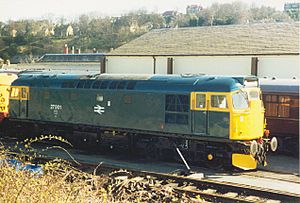British Rail Class 27 facts for kids
Quick facts for kids BRCW Type 2British Rail Class 27 |
|
 |
|
| 27001 at Bo’ness | |
| Power type | Diesel-electric |
|---|---|
| Builder | Birmingham Railway Carriage and Wagon Company |
| Serial number | DEL190–DEL258 |
| Build date | 1961–1962 |
| Configuration | Bo-Bo |
| UIC classification | Bo'Bo' |
| Gauge | 4 ft 8 1⁄2 in (1,435 mm) |
| Wheel diameter | 3 ft 7 in (1.092 m) |
| Minimum curve | 5 chains (100 m) |
| Wheelbase | 39 ft 0 in (11.89 m) |
| Length | 50 ft 9 in (15.47 m) |
| Width | 8 ft 10 in (2.69 m) |
| Height | 12 ft 8 in (3.86 m) |
| Locomotive weight | Originally: 72.50 long tons (73.7 t) |
| Fuel capacity | 685 imperial gallons (3,110 L; 823 US gal) |
| Prime mover | Sulzer 6LDA28-B |
| Transmission | DC generator, DC traction motors |
| Multiple working | ★ Blue Star |
| Top speed | 90 miles per hour (140 km/h) |
| Power output | Engine: 1,250 horsepower (930 kW) At rail: 933 horsepower (696 kW) |
| Tractive effort | Maximum: 42,000 pounds-force (190,000 N) Continuous: 25,000 pounds-force (110,000 N) |
| Train heating | As built: Steam generator 27/2: ETH |
| Locomotive brakeforce | 34 long tons-force (340 kN) |
| Train brakes | Vacuum, some later dual Air & Vacuum |
| Career | British Railways |
| Number | D5347–D5415; later 27001–27066 |
| Axle load class | Route availability 6 (RA 5 from 1969) |
The British Rail Class 27 was a type of diesel locomotive used on British Rail tracks. These powerful engines were built by the Birmingham Railway Carriage and Wagon Company (BRCW) between 1961 and 1962. They were an improved version of an earlier model, the Class 26. In total, 69 of these locomotives were made.
Contents
Discover the British Rail Class 27 Locomotive
The Class 27 was a special type of train engine known as a diesel locomotive. This means it used a diesel engine to create electricity, which then powered motors to turn the wheels. These engines were designed to be strong and reliable for pulling trains across Britain.
Building These Mighty Engines
The Class 27 locomotives were built by a company called the Birmingham Railway Carriage and Wagon Company (BRCW). They made these engines over two years, from 1961 to 1962. Each locomotive was given a unique number, starting with D5347 and going up to D5415. Later, these numbers were changed to start with 27, like 27001.
These engines were an updated version of an earlier design, the Class 26. Both types were originally called "Type 2" locomotives by BRCW.
What Made the Class 27 Special?
The Class 27 engines were known for their strong performance. They could reach a top speed of 90 miles per hour (about 145 km/h). This made them useful for both passenger trains and freight trains. They had a powerful Sulzer engine that produced 1250 horsepower.
They were also designed to work together. This feature, called "Blue Star" multiple working, meant that two or more Class 27s could be controlled by a single driver. This was very helpful for pulling very long or heavy trains.
Where Did They Go?
The Class 27 locomotives were mainly used in Scotland. They pulled many passenger trains, especially on routes around Glasgow and Edinburgh. They also worked on freight services, moving goods across the country.
Some Class 27s were also used in other parts of Britain, including around London. They were a common sight on the railways during the 1960s and 1970s.
End of the Line and Preservation
Over time, newer and more modern locomotives were introduced. This meant that the Class 27s slowly started to be retired from service. Many of them were withdrawn during the 1980s.
However, some of these historic engines were saved! A few Class 27s are now preserved in railway museums and heritage railways. This allows people today to see and sometimes even ride behind these classic British locomotives.
Images for kids
-
27001 at the Bo'ness and Kinneil Railway
-
27066 on the Dean Forest Railway





